--27c and 321 Massey Harris Manure Spreader (1949-73)
The Farm Equipment models are my favourites and I recently received the first casting of the 27c Massey-Harris manure spreader. I now have the first 2 castings together. I like to show this with some more information as an addition to the closed TMT topic. I namely found some interesting brochures that I have not seen in a discussion before and who might help in the discussion.

Massey Harris Spreader No. 11. Prototype of Dinky Toys 27c 321.

Massey-Harris manure spreader is a part of the post-war 27 series farm equipment. Here together pictured in catalogue UK 1957.
Massey-Harris:
Canada's most important tractors producer was Massey-Harris.
It was founded in 1847 in Newcastle, Ontario Canada. Massey-Harris was founded by Daniel Massey as the "Newcastle Foundry and Machine Manufactory". In 1891 the "Newcastle Foundry and Machine Manufactory" merged with A. Harris, Son & Co. Ltd. to Massey-Harris Co.
After a few unsuccessful attempts in the field of tractors, production did not really begin until 1928, with the acquisition of a tractors factory. The first articulated tractor was already innovative and the Twin Power tractors of 1938 continue that progressive trend. After the war, the 44 K (=Dinky Toys 27a – 300=) became Massey Harris's bestseller.

Massey Harris 44k in agricultural museum Tiengemeten in the Netherlands which I personally photographed
From 1948, production was not only in Toronto, but also in Great Britain: first in Manchester, later in Kilmarnock in Scotland.
In 1953, the company merged with the Ferguson Company to become Massey-Harris-Ferguson, before eventually changing to the current name Massey Ferguson in 1958. The brand has been producing agricultural machinery under the name Massey Ferguson. But the company soon began to fall financially. Faced with increasing international competition and a declining agricultural sector in importance, the company was struggling.
Massey Ferguson Limited is an American manufacturer of agricultural equipment, formed by the 1953 merger of farm machinery manufacturers Massey Harris of Canada and the Ferguson Company in Northern Ireland. It was based in Brantford, Ontario, until 1988. The company transferred its headquarters to Buffalo, New York, in 1997, before it was acquired by AGCO, the new owner of its former competitor Allis-Chalmers. Massey Ferguson is one of several brands produced by AGCO and remains a major seller around the world.
Brochure Massey Harris Spreader No. 11
Brochure Massey Harris Spreader No. 11
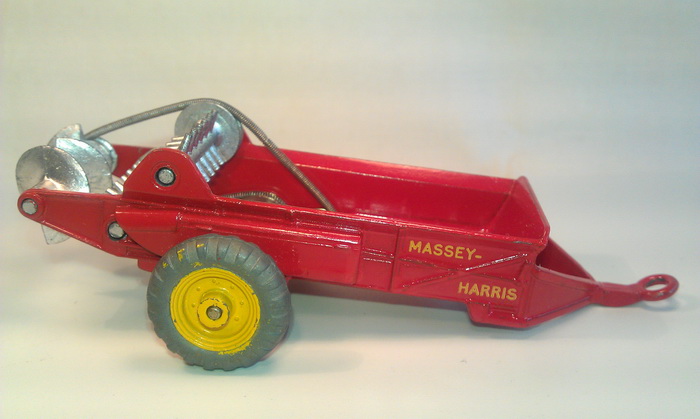
My 1st version 27c Massey-Harris manure spreader

Introduction 27c Massey-Harris manure spreader in MM October 1949
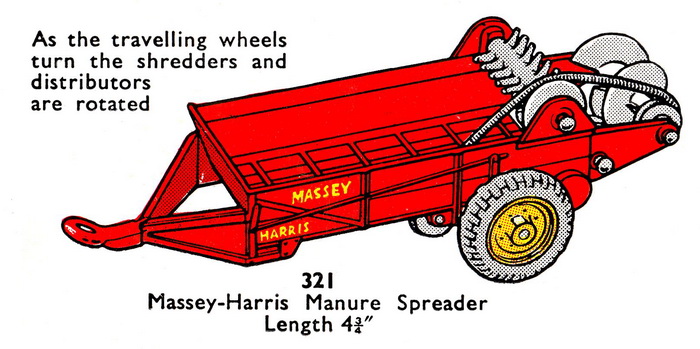
321 in catalogue UK 1956.
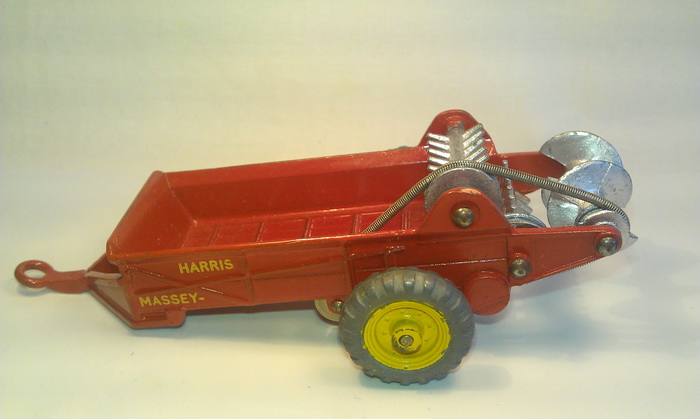
27c 1st version
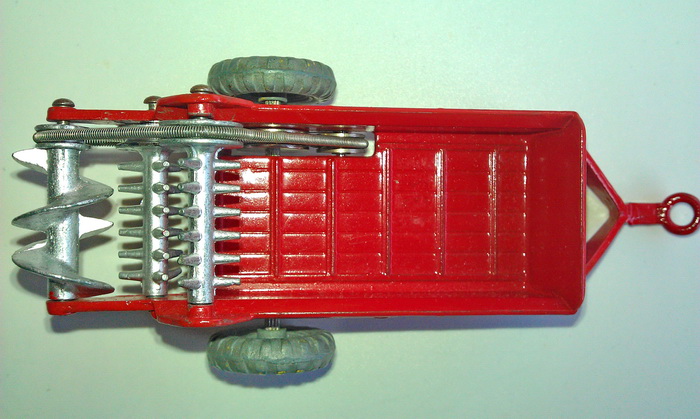
27c 1st version top view
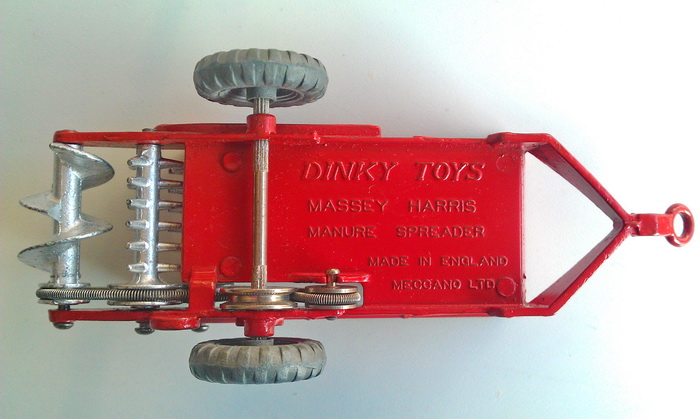
My 27c 1st version without number and without paint ring in flat base. Metal wheels.
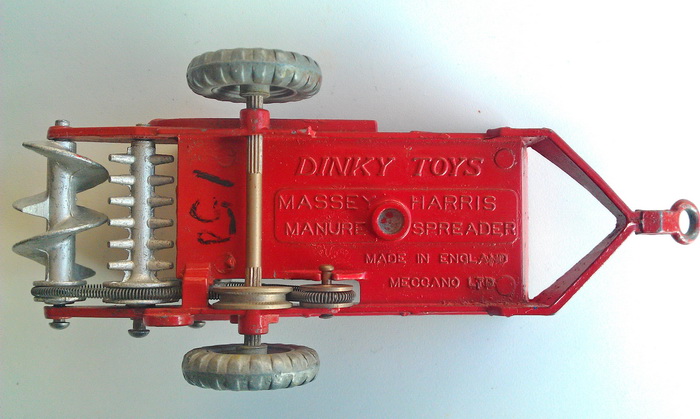
My 27c 2nd version without number and with paint ring on a raised cartouche in base. Pencil price 150 on base. This is the USA $ 1,50 price in USA catalogue 1952. Written on the base, because I think it is individually sold from a Trade box of 3 pieces. I received it from USA in a not dual numbered 321 box, but in my opinion is it not an original combination and is my 27c combined/swapped with a 321 box, instead of the original 27c trade box.

My 2nd version with swapped box 321
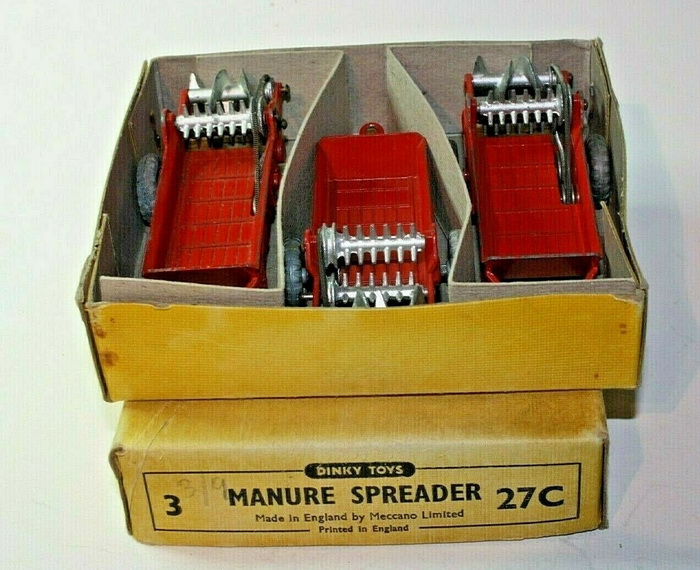
27c tradebox with 3 pieces. The box that was supposed to be the box of my 27c.
The following casting variations are known. See also this extensive topic in TMT with the link: http://www.talkmodeltoys.com/discus/messages/27668/11510.html?1205423232
- 27c without number, without painting ring on a flat base. Metal wheels.
- 27c without number, with painting ring on a raised cartouche in base. Metal wheels.
- 27c with number 27c, with painting ring on a raised cartouche in base. Metal wheels.
- 321 with number 321, with painting ring on a raised cartouche in base. Metal wheels.
- 321 with number 321, with painting ring on a raised cartouche in base. Plastic wheels.
Casting number 3 was not shown in TMT, so I will show it here:
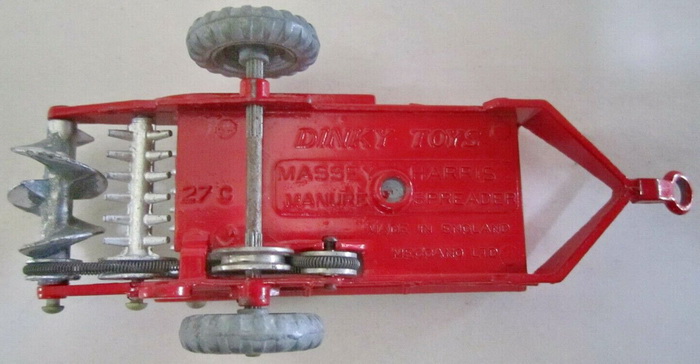
321 appeared for the last time pictured in the UK catalogue 1st February 1972 No. 7 and for the last time in the Meccano order form of September 1973 for the price of £ 0,55. A production timeline of 24 years, so it must have been a very popular model.
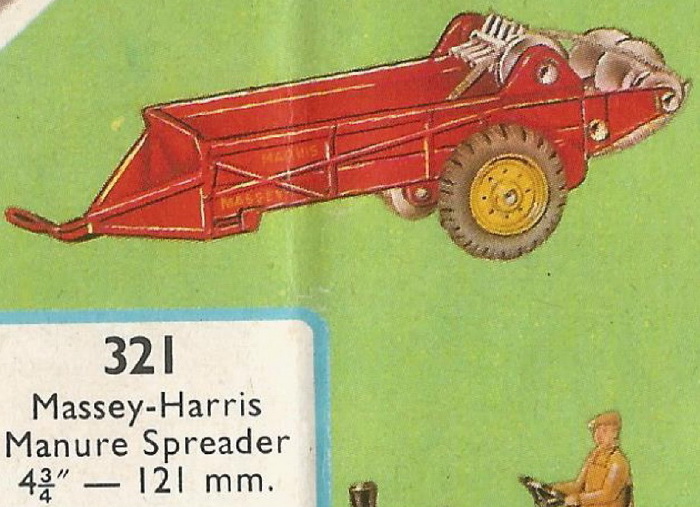
1965 catalogue UK. 321 for the last time pictured with metal wheels and Massey-Harris transfers.
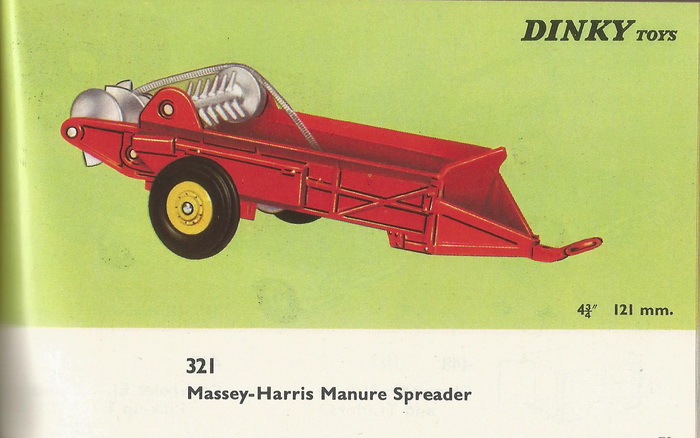
1966 catalogue UK. 321 for the first time pictured with plastic wheels and without Massey-Harris transfers.
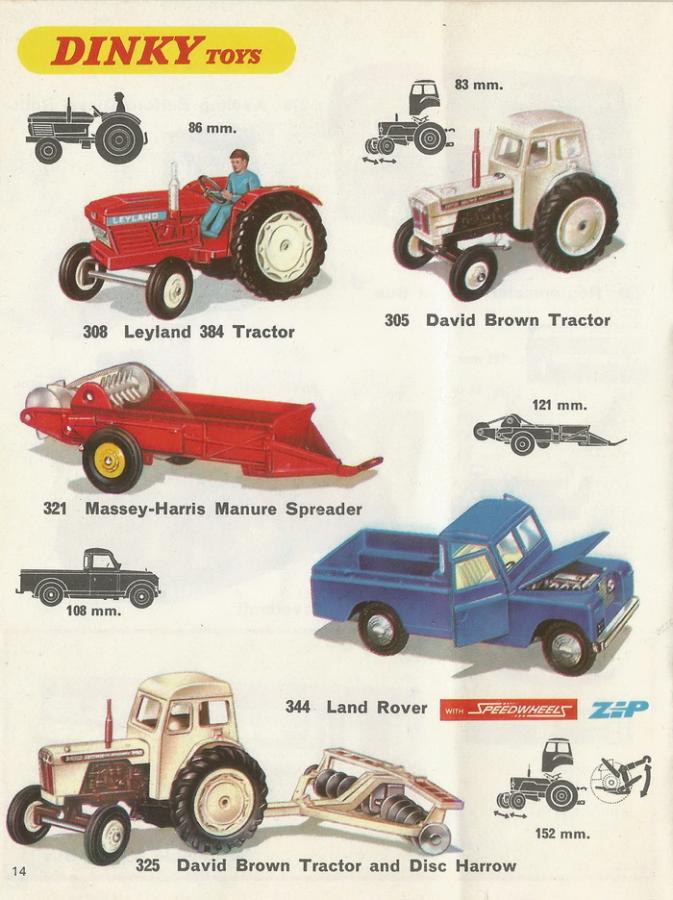
1972 catalogue UK. 321 for the last time pictured with plastic wheels and without Massey-Harris transfers
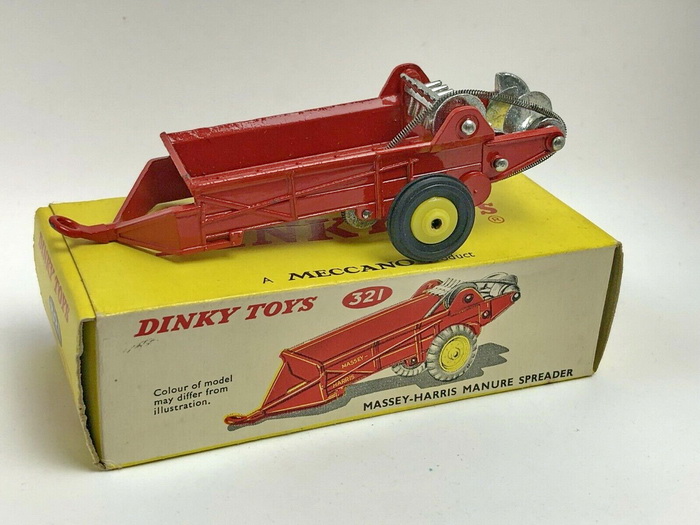
321 with plastic wheels and without Massey-Harris transfers
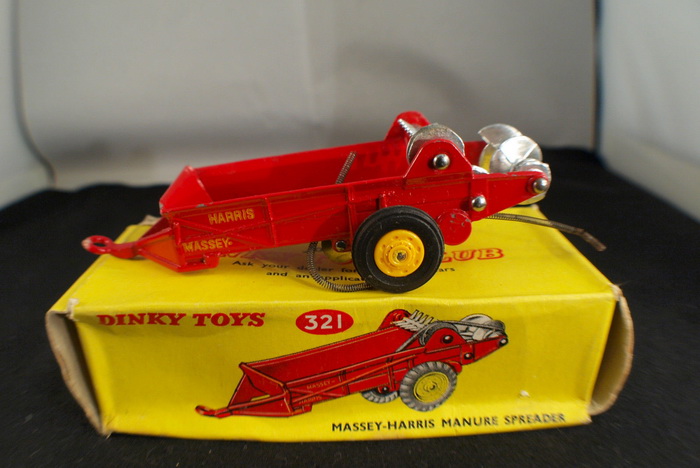
321 with plastic wheels and with Massey-Harris transfers. As you can see on the pictures above is there also a difference in the type of plastic hubs.
Note:
I have always found it very strange why Meccano Liverpool did not change the name of the Massey-Harris manure spreader to Massey-Ferguson as they did with the Massey-Harris tractor and tried to find out more.
In TMT Jan Werner noted already the omission of the Massey-Harris transfers on the 321 in the end of production. About the same happened from 1964-1966 when the 300 Massey-Harris tractor was depicted in the catalogues without brand name transfers and the 300 tractor for a short period of time was issued as Massey-Harris without brand name transfers. But ... it eventually became the brand name Massey-Ferguson.
It is striking that from 1966 to 1973 the 321 in the catalogues still is named Massey-Harris, but without the brand name transfers of Massey-Harris, as usual from the start of production. And … after the takeover of Massey-Harris by Massey-Ferguson it did not get the brand name Massey-Ferguson, like the 300 Massey-Harris tractor did, of which from 1966 to the end of production in 1971 the name and the transfers changed from Massey-Harris to Massey-Ferguson. And … it got its own box.
There is still something else striking... According GBofDT the 321 got plastic wheels in 1962. When you search on Ebay and Vectis almost all of the 321 with plastic wheels don't have Massey-Harris transfers, but some still have. Apparently the 321 with plastic wheels still got for some time the Massey-Harris transfers, after which at some time it was omitted till the end of production in 1973. Was it still to clean up the stock of the transfers, or was it another reason.
It remains namely a mystery why Meccano Liverpool, after the acquisition of Massey-Harris by Massey-Ferguson, did not treat the 321 manure spreader at the same way as the 300 tractor, while Massey-Ferguson manufactured exactly the same manure spreader no.11 with the brand name Massey-Ferguson, see picture below.
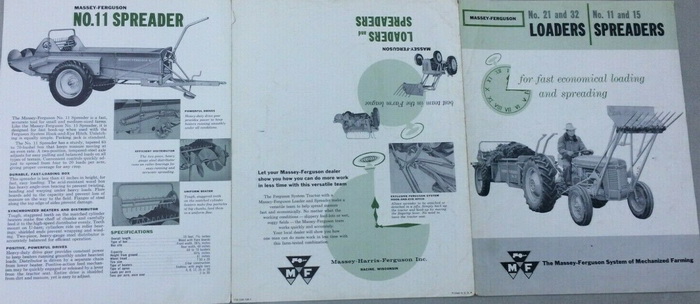
Brochure Massey-Ferguson manure spreader No.11 - equal to Massey-Harris manure spreader No.11.
It is all the more a mystery because Massey-Ferguson, as far as I could find out, never took over the Massey-Harris 44 under the Massey-Ferguson brand name into production, about which Massey-Ferguson apparently did not protest to Meccano Liverpool when they changed the 300 Massey-Harris to the never produced Massey-Ferguson, as happened in the 965 Euclid Terex case. This in contrast to the Massey-Harris manure spreader no.11, which Massey-Ferguson took over into production under the same type of name, given the brochure above.
There was no obstacle whatsoever for Meccano Liverpool of taking over the Massey-Ferguson brand name for the manure spreader, but they did not do it. I think that we can take now a more soundly based conclusion that Meccano Liverpool did not want to change the brand name of Massey-Harris manure spreader to Massey-Ferguson manure spreader to save production costs. It's a pity they didn't label it till the end of production and didn't change this model to Massey-Ferguson.
Jan Oldenhuis 10 February 2020.
I forgot to illustrate how illogical Meccano Liverpool worked.
In 1966, the 300 Massey-Harris tractor (until 1971) was equipped with Massey-Ferguson transfers, while in the same year the transfers of the Massey-Harris manure spreader were omitted and the model from 1966-1973 was issued without brand name transfers.
With the knowledge that the Massey-Harris 44 tractor was never produced by Massey-Ferguson, while that was the case with the Massey-Harris manure spreader 11, this is an incomprehensible and illogical decision of Meccano Liverpool. What did they talk about in the director's room?
Jan O
Jan
An other great well researched article.
Many thanks
Jacques
Thanks Jan, for this very nice explanation and documentation!
I can’t help admiring this model for its relative complexity, with its many moving interactive parts, and driven by a metal spring. A part of the large factory drawing below (the full image is included in the ‘documents’ section, for registered members only) demonstrates the admirably struggling with the complexity of the design and functioning parts.
Perhaps this is also the place to remind that the Manure Spreader was also included in the very scarce French gift set no. 27ac Tracteur Massey Harris et remorque épandeur d’engrais, a 1950 import from Liverpool, the combination packed in an attractive French red folding open lid box.
Kind regards, Jan W
To add to the previous posts, here is some more information about this manure spreader.
There are now eight known versions :


This is the version 6 with spun brass pulleys and split pin wheel axle
There may be an explanation why Meccano deleted the tampoo (not transfer) marking MASSEY HARRIS and did not change it to MASSEY FERGUSON. The word FERGUSON is longer by two letters and would not have fitted in the small area of the right hand side. The cost of a new tampoo was not important, the main cost was to apply the tampoo to the model. Why was the splined rear axle changed is an other question.
I am looking for a icture of the last version with the red plastic hubs. Can anyone help ?
Jacques. Here are 2 pictures of a 321 with red plastic hubs. Currently on auction on Ebay with the link: https://www.ebay.co.uk/itm/DINKY-TOYS-MODEL-No-321-MASSEY-HARRIS-MANURE-SPREADER-RARE-RED-WHEELS-MIB/401961097010?hash=item5d96bf9732:g:fHAAAOSwPYZU-awW
Jan O
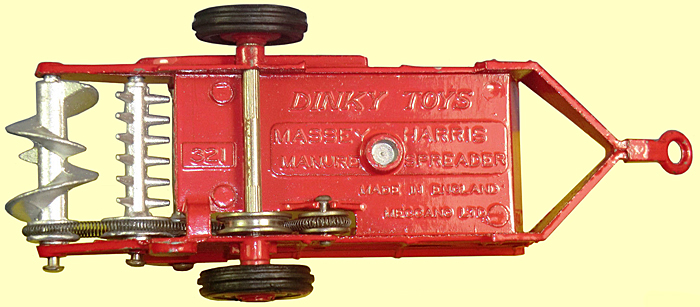
version 8 with red plastic hubs.
I am sorry but I have been mislead about the version 6, it must be a code 3. There was no reason to use this expansive roll pin over the axle. This axle must have been cut for some reason and mended with the pin. Thanks to Jan O, I have now two pictures of the very last version of the manure spreader with the very rare red plastic hubs and the wheel axle is the same as all the other versions.
I have up-dated the list of versions in my previous post.
Jacques. In response to your post # 5 and # 7.
On Ebay I found 3x 321 with yellow plastic hubs with no paint ring, flat base and flat number 321 cast-in (no raised cartouches). Are these an unknown version or are they manupilated? All 3 have a split pin wheel axle.
I also found 6x 321 with a red coloured paint ring, yellow plastic hubs, split pin wheel axle and the pulleys of these seem brass. There are so many with a split pin wheel axle. All ones with a red coloured paint ring I could find have a split pin wheel axle. It seems a normal practice. Are these spare parts? I could not find them.
Do we still have to conclude that they all are not original? Some look like new and descriptions of all these don't talk nothing about it. It's clearly to see that the last one does not have a broken axle or something. How do we have to determine this? For me it's a mystery.
Jan O
That is interesting Jan.
I wondered about the use of roll pins to replace brass axles. Initially I agreed that this must have been a clever repair, which I thought would have required a modification to the hole sizes on the trailer. With the original brass axle I presume that the 'splines' were knurled into the axle to provide an interference fit with the wheels and the brass collar, in order that the collar and wheels should all rotate together and provide the drive to the pulley train.
The knurling must have been done during the manufacture of the axles and therefore, to allow assembly and rotation, the axle holes on the underside of the muck spreader had to be slightly larger than the holes in the wheels and collar. That would allow the roll pins to rotate just as easily as the brass axles.
John. Thank you for your very welcome addition. I myself have too little technical knowledge about the later models. I am more visual set.
I think I misinterpreted Jacques's description in posts # 5 and # 7. Now that I have reread the modified list of versions of Jacques and compare them with my photo examples, I have to conclude that all my examples are original and I doubted that at first.
Kind regards, Jan O
Jan O, I'm sure that a clever engineer or assembler at Binns Road earned him or herself a cash bonus when they suggested this cheaper alternative to brass axles.
John and Jacques. I found it very surprising to discover that the last model 9 in the versions list of Jacques had again a flat base with 321 cast-in, without paint ring and is (almost) the same as the very first model 1 with flat base, without number and also without paint ring.
What is striking about the 321 is the curved towbar. As a result, many eyes have broken off the towbar. It is incomprehensible that this error has never been corrected during the entire production period of 24 years.

The latter model 321 is also the only one with the modern brand name designation DINKY toys on the base, such as the modern logo depicted in the DT catalog 1972 in which the 321 was last depicted.

Jacques thank you very much for the very plausible explanation for the omission of the Massey Ferguson brand name on the model.
Jan O
More samples have come up so now we have ten known versions. Are there any others ? For some reason the steel splined axle (not brass as this alloy is too soft for an axle) was not available any more and Meccano changed the design to the roll pin which is more expansive than the splined axle. I thought that the model with red plastic hubs was the latest issue but not at all, it is the version four only out of ten.
The 10th version is quite a surprise as all the marking has been changed, there are no more raised areas, the word TOYS is smaller thant DINKY which dates this version after 1971 and the manufacturer's name has been deleted. Does this mean that the manufacturing has been sub-contracted to an other firm in England ?
Today, kasvd comes with an other very rare version which is fited with red Supertoys hubs. This must be the version 5. I have search the net but could not find a similar one.
kasvd could you please post a picture of the left hand side of your 321 and a photo of the base framed with all the tyre, both of these on a light coloured background ?
Thanks and regards.
Jacques. It is indeed striking that the name of Meccano Ltd as the manufacturer of the product is not stated on the base. After all, Meccano Liverpool always mentions the name Meccano Ltd on its products. As you says, this suggests that the model was manufactured by a subcontractor. Maybe this was Joal in Spain? In the past I made a contribution in the following link about Massey Harris Manure Spreader model 204 from Joal: http://www.dtcawebsite.com/forum-topic/321-massey-harris-manure-spreader-1949-1973-versus-joal-204-massey-harris-repartidor-de
Apparently, Joal recreated the Model 204 with Meccano Dinky Toys tools and may have manufactured the Model 321 as subcontractor for Meccano Liverpool at the time? It's just an idea, but I also realize that it does not stroke with the wording Made in England.
Jan O
Dear Jan,
I did notice the similarity between some Dinky Toys and Joal models and I purchassed the Joal manure spreader, the multibucket unit, the cement mixer and the Blaw knox bulldozer. Although they are very similar, none of them has been made with Meccano tools. They must have been made from the same drawings provided by the manufacturers and as they are at the same scale, they look very similar. If the manufacturing of the manure spreader was sb -contracted we must look else where but not in Spain as the spreader's marking still reads "MADE IN ENGLAND".
I still think that Meccano's policy was to keep the old tools and not to sale them. Some very old tools have been used years later like the rotor of the Autogiro which has been fitted 17 years later on the Bristol heicopter ref. 715.
'Colour of model may differ from illustration', says the text on the new, sturdy box. Still, the colour never changed at all. Things that did change were the wheels/tyres and the presence or not of the Massey-Harris brand name. As this revised box design came with the latest models only, it is peculiar that these obvious characteristics were not changed at all on the 'new' illustration of the model.
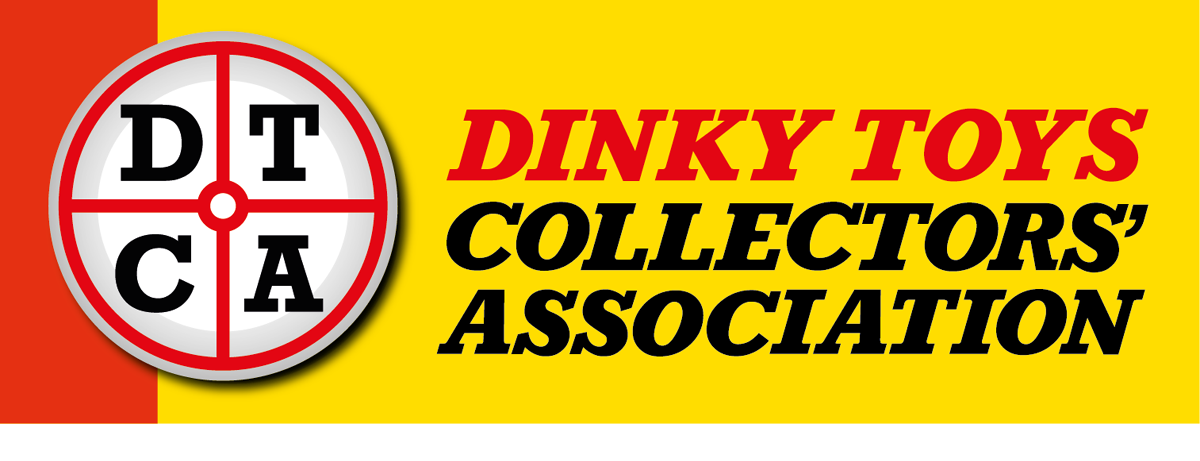

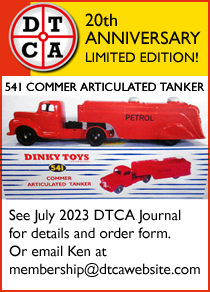





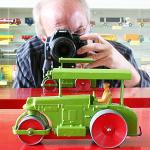
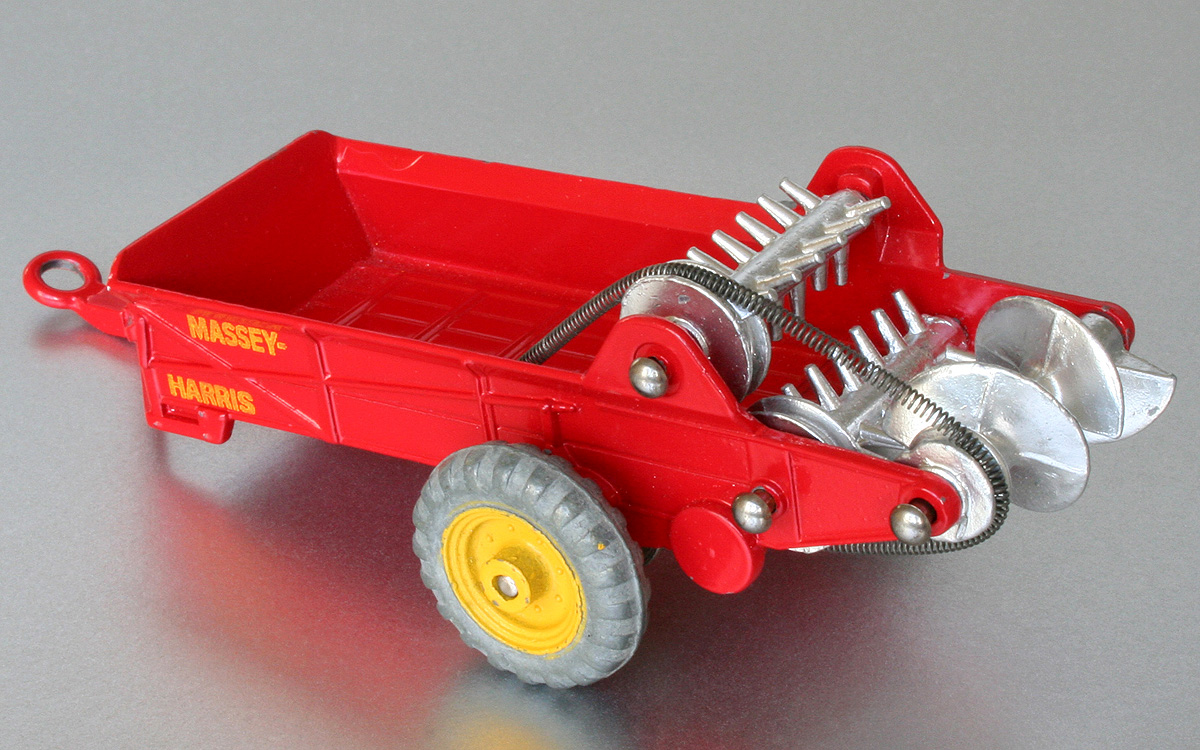


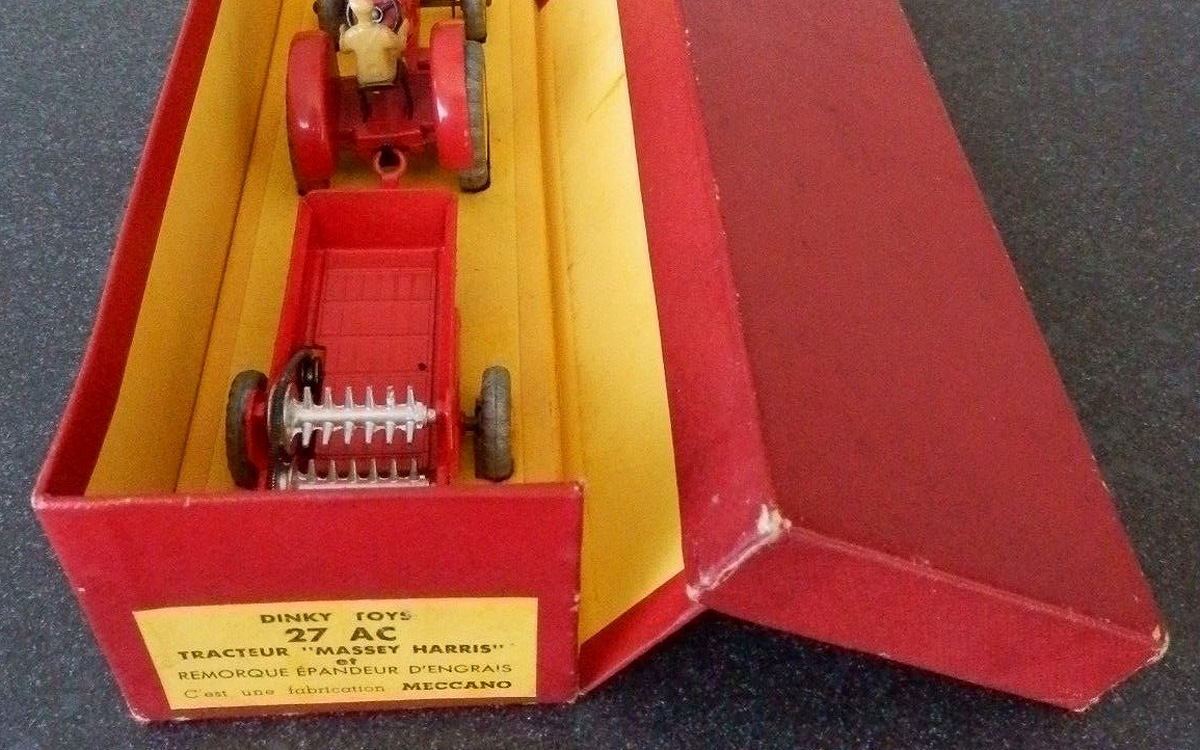

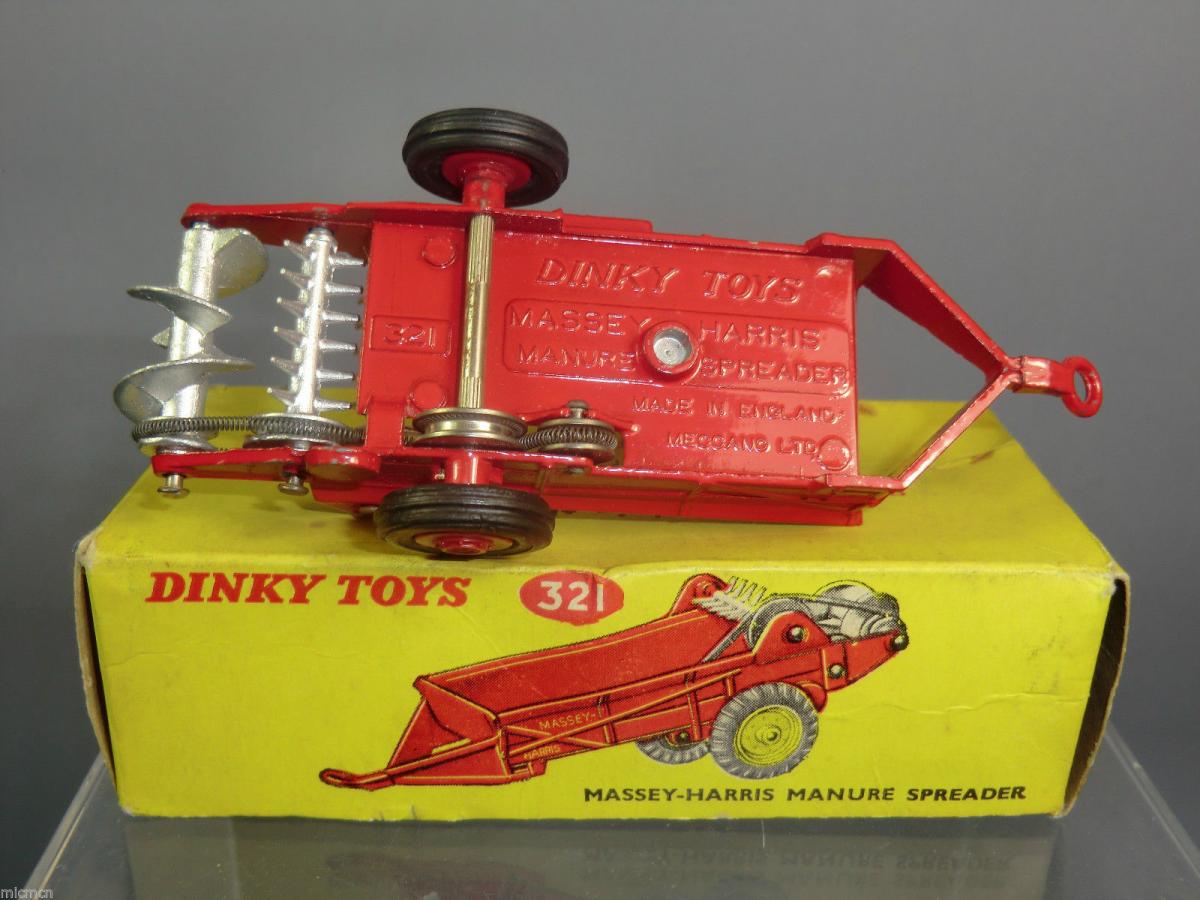

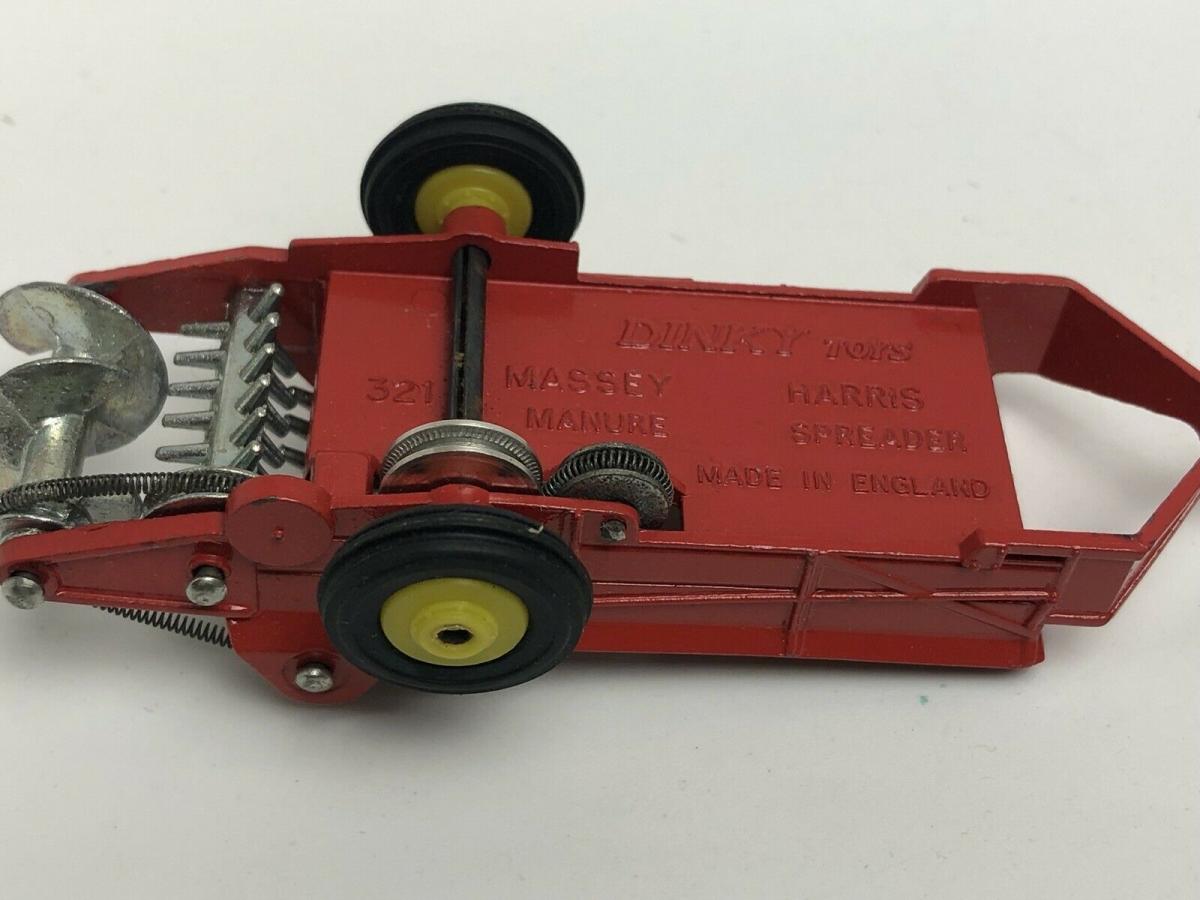
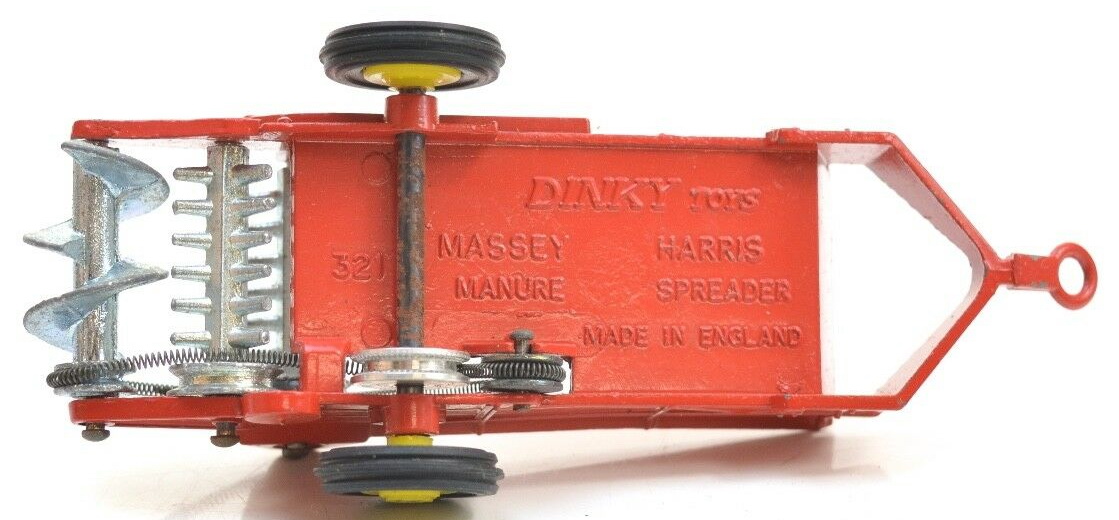



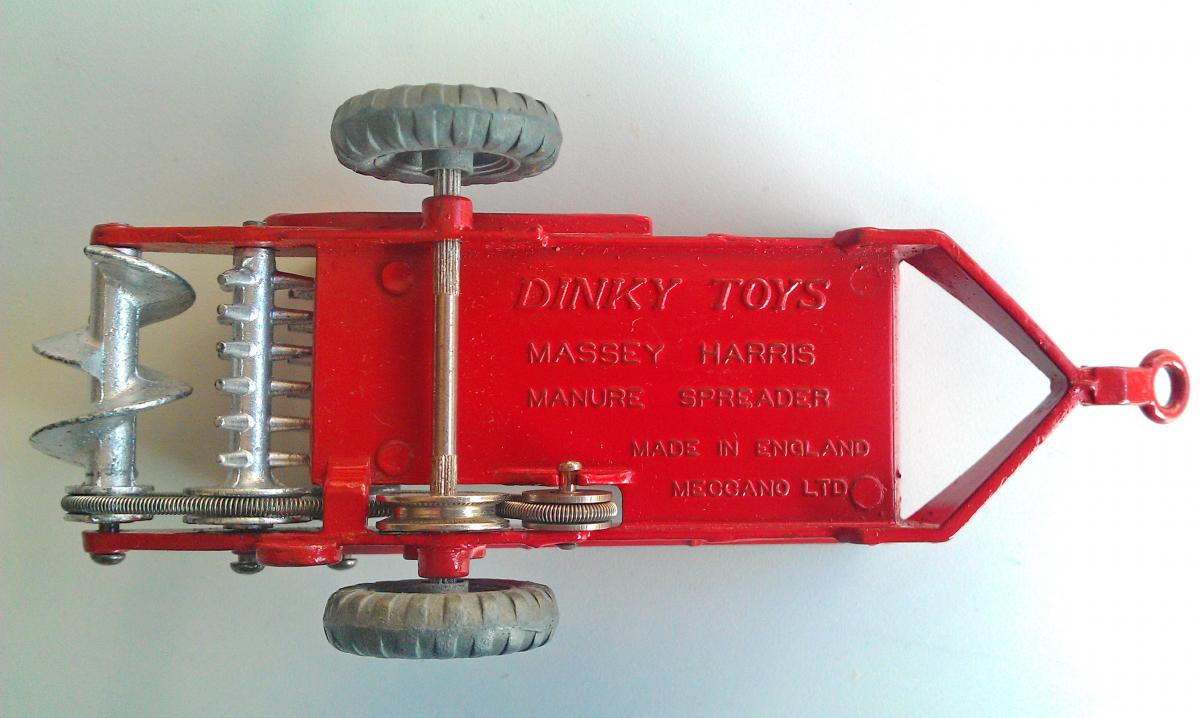

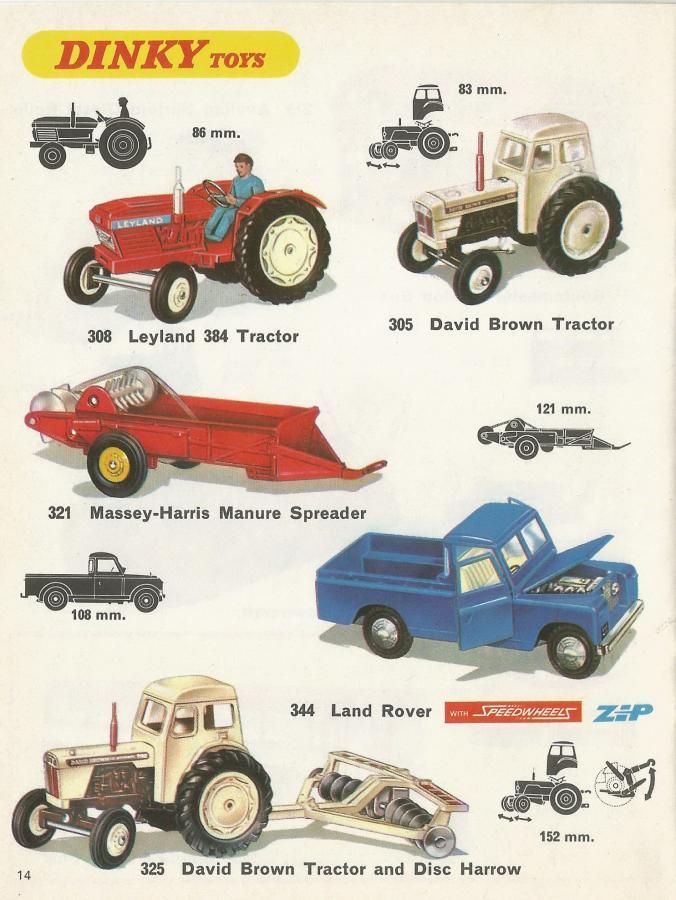
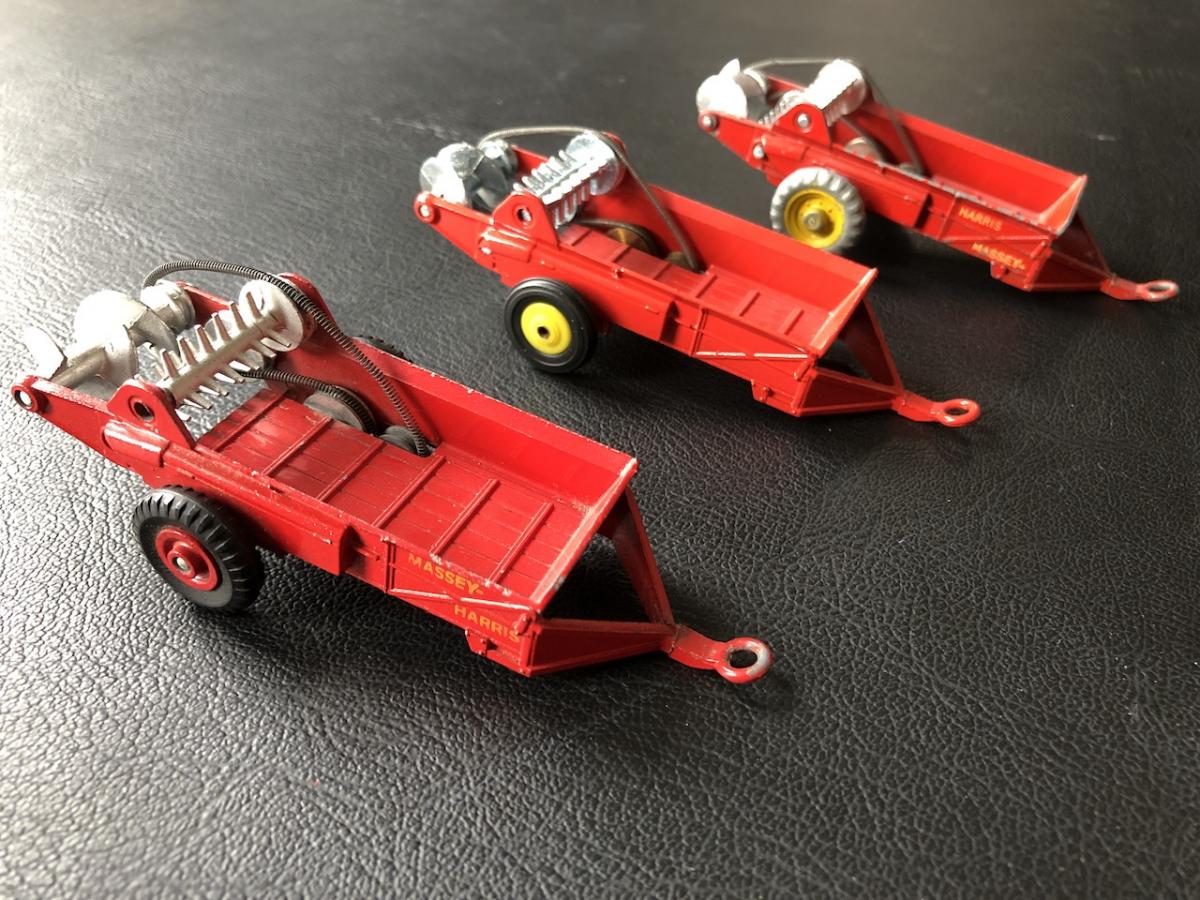
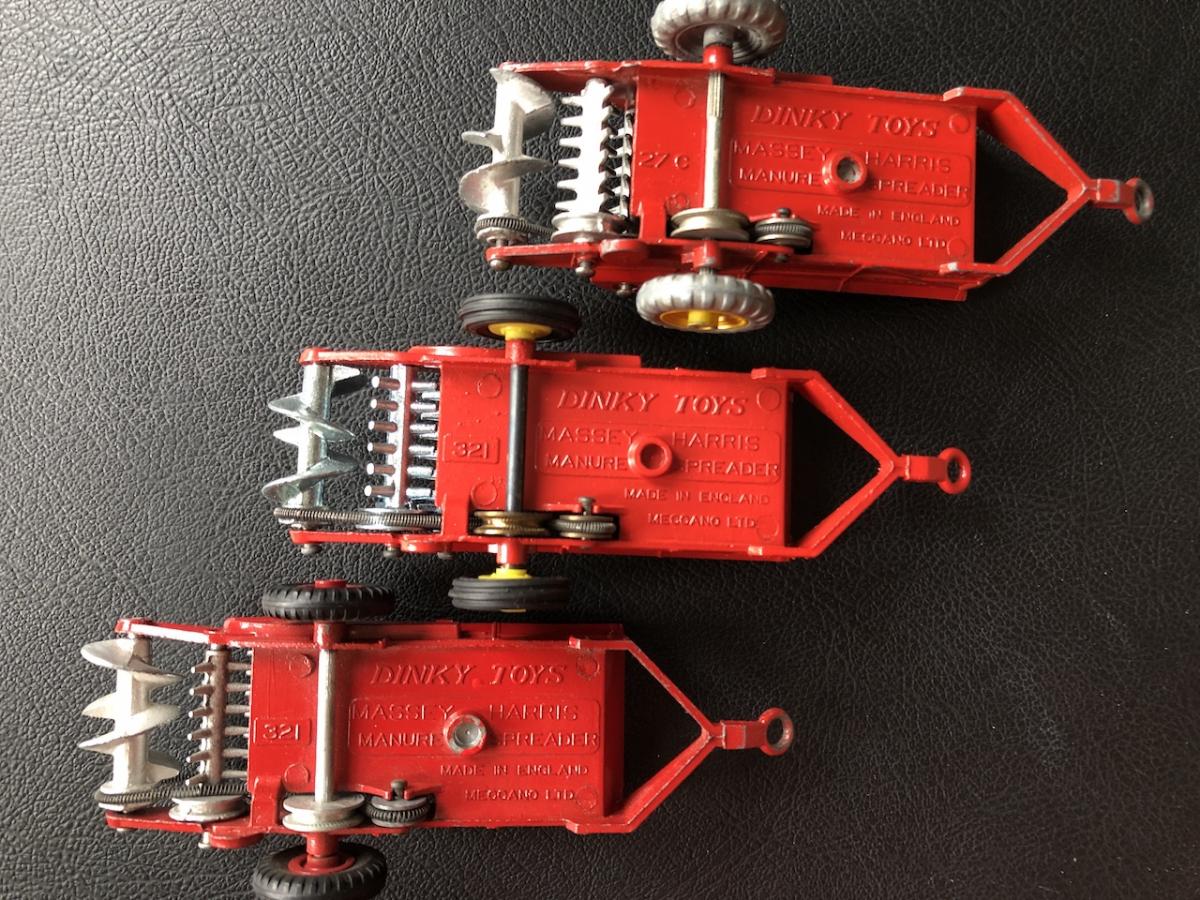



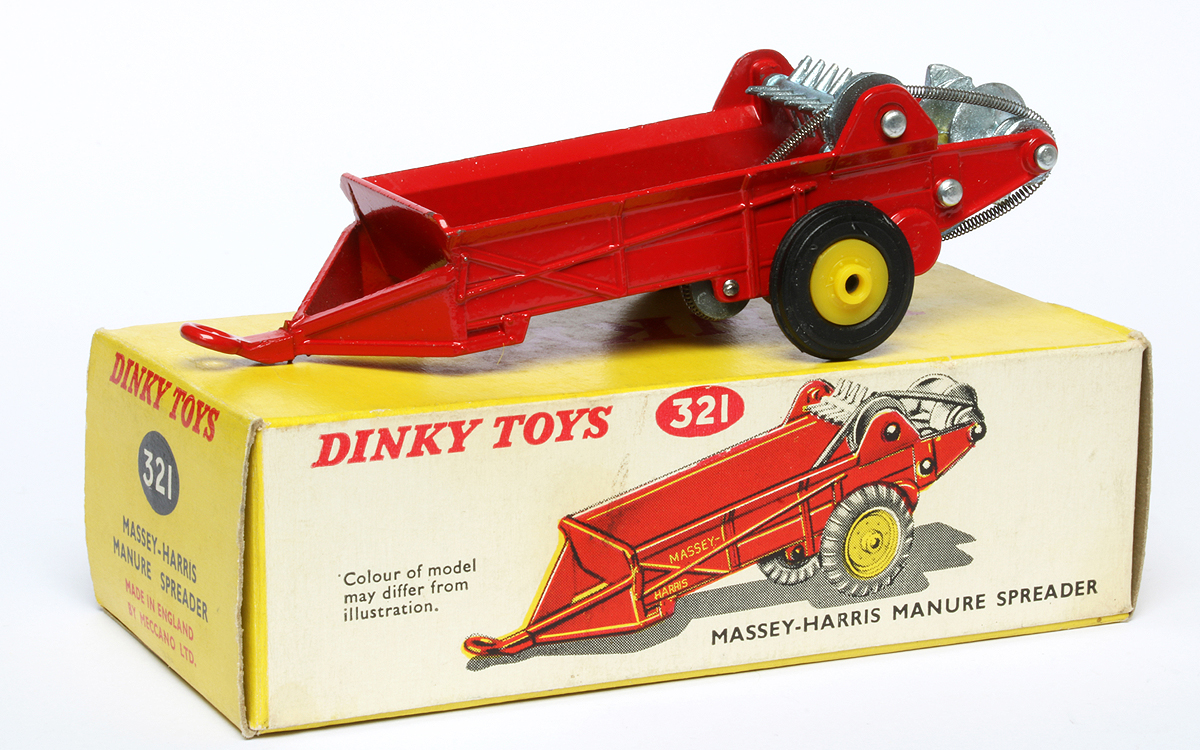
-914 AEC Articulated Lorry (1965-70)
-163 Bristol 450 Sports Coupé (1956-60)
-163 Bristol 450 Sports Coupé (1956-60)
-914 AEC Articulated Lorry (1965-70)
DTCAwebsite upgrade 2023
DTCAwebsite upgrade 2023
DTCAwebsite upgrade 2023
DTCAwebsite upgrade 2023
DTCAwebsite upgrade 2023
DTCAwebsite upgrade 2023
-508 DAF
--14c and 401Coventry Climax Fork Lift Truck (1949-64)
FRENCH DINKY TALBOT LAGO
-Boxes General Discussions including end flaps, both British and French
--14c and 401Coventry Climax Fork Lift Truck (1949-64)
--14c and 401Coventry Climax Fork Lift Truck (1949-64)
-508 DAF
DTCAwebsite upgrade 2023
DTCAwebsite upgrade 2023
DTCAwebsite upgrade 2023
DTCAwebsite upgrade 2023
DTCAwebsite upgrade 2023
-508 DAF
-508 DAF
-508 DAF
New arrivals
New arrivals
DTCAwebsite upgrade 2023
DTCAwebsite upgrade 2023
ORIGINAL MECCANO DINKY TOYS FACTORY BOX ART 175 HILLMAN MINX SALOON + DRAWING
--29c and 290 Double Decker Bus (1938-63)
DTCAwebsite upgrade 2023
DTCAwebsite upgrade 2023
DTCAwebsite upgrade 2023
DTCAwebsite upgrade 2023